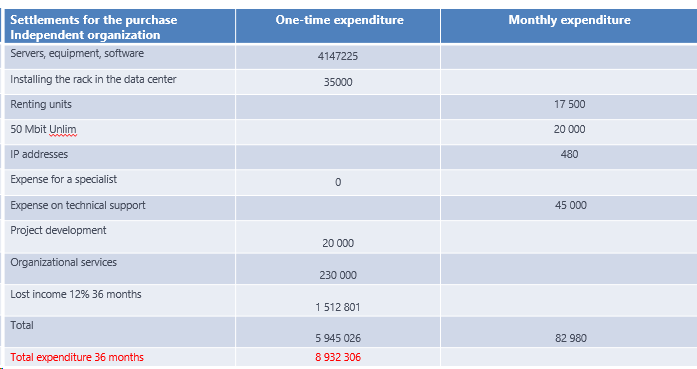When it comes to investing in new hardware and software, organisations choose between different types of infrastructure models. Which is better - on-premises, virtual servers in the cloud or hybrid? Many choose the former because it is cheaper. They do a very simple calculation - compare the price of equipment purchase and maintenance with the cost of services from cloud providers, and then make a decision.
This is the wrong approach. Cloud4Y explains why.
It is important to understand that TCO is not just a fixed value. It is the amount of money a company invests from the moment it buys the equipment until it is completely disposed of. As such, it reflects the economic impact over the entire lifecycle of IT projects.
What is TCO?
The Gartner Group officially introduced the term TCO (Total Cost of Ownership) in the 1980s. Initially, it was used in their research to calculate the financial cost of ownership of Wintel computers, and in 1987, they finally formulated the concept of Total Cost of Ownership to be used in the business world. It turns out that the model for analysing the financial aspect of using IT equipment was created in the last century.
The following formula is generally accepted for calculating TCO
TCO = Capital Expenditure (CAPEX) + Operational Expenditure (OPEX)
Capital expenditure (or one-off, fixed costs) is simply the cost of acquiring and implementing IT systems. They are called capital costs because they are incurred once, in the initial stages of building information systems. They also include future operating costs:
-
Project development and implementation costs;
-
The cost of external consultants;
-
The initial purchase of the necessary basic software;
-
The initial purchase of hardware and additional software.
Operational expenditures are directly related to the operation of IT systems. They include:
-
The cost of maintaining and upgrading the system (staff salaries, external consultants, outsourcing, training programs, certifications, etc.);
-
Complex system management costs;
-
Costs associated with the active use of the information system by users.
The new way of calculating costs has become popular among companies. Managers have come to understand that, in addition to direct costs (equipment costs, staff salaries), there are also some indirect costs. These include the salaries of managers not involved in working with the equipment (IT manager, accountant), advertising costs, rent, etc. There are also non-operating expenses: interest payments on loans, financial losses due to currency fluctuations and payments to contractors. These should certainly be included in the total cost of ownership formula.
TCO calculation
To make things clearer, let's list all the variables in our Total Cost of Ownership formula. We start with the capital cost of hardware and software. Our total cost includes
-
Server Hardware
-
Storage
-
Virtualization platform
-
Information security equipment (crypto-gateways, firewall, etc.)
-
Network equipment
-
Backup system
-
Internet (IP)
-
Software licences (anti-virus software, Microsoft licences, etc.)
-
Creation of a disaster recovery plan (redundancy to 2 data centres if necessary)
-
Data centre colocation / rental of additional space
Associated costs to consider include:
-
IT infrastructure design (specialist recruitment)
-
Equipment installation and set-up
-
Infrastructure maintenance costs (staff salaries and consumables)
-
Lost profit
Here are the calculations for one company


As you can see from this example, migrating to a cloud infrastructure is justified - cloud solutions are not only comparable in price to on-premises solutions, they are even cheaper. Yes, you have to calculate everything yourself to get objective figures. This is more difficult than simply evaluating the purchase price. But in the long run, a careful analysis is always more effective than a quick one. Effective management of operational costs can significantly reduce the total cost of ownership of IT infrastructure and free up budget for new projects.
There are other arguments in favour of cloud servers. The company saves money by eliminating one-off hardware purchases, optimises the tax base, gets instant scalability and reduces the risks associated with owning and managing information assets.



